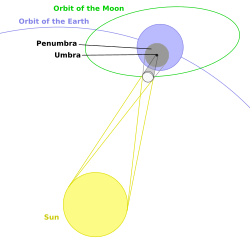What is a Solar Eclipse?
A solar eclipse occurs when the Moon passes between the Sun and the Earth so that the Sun is wholly or partially obscured by the moon. This can only happen during a new moon, when the Sun and Moon are in conjunction as seen from the Earth.
At least two and up to five solar eclipses occur each year on Earth. Total solar eclipses are rare at any location because during each eclipse totality exists only along a narrow corridor on earth in the relatively tiny area of the Moon's umbra. A total solar eclipse is a spectacular natural phenomenon and many people travel to remote locations to observe one.
In ancient times, and in some cultures today, solar eclipses have been attributed to supernatural causes, as the Sun seems to disappear in the middle of the day and the sky darkens in a matter of minutes.
August 1, 2008 Total Solar Eclipse:
The total eclipse will be visible in the northern and eastern parts of North America, Greenland and northern
The sky gazers in
"The partial eclipse will be seen in the north-eastern region, starting from about 4 PM. In parts, northern
Timing of Eclipse in various Regions of the World:
* 08:04 UTC (GMT) - Beginning of the general eclipse
* 09:23 UTC (GMT) or 04:23 local time- Total Solar Eclipse begins in northern Canada (Nunavut) (GMT-05)
* 09:30 UTC (GMT) or 07:30 local time- northern Greenland (GMT-02)
* 10:00 UTC (GMT) or 14:00 (02pm) local time- Novaya Zemlya (GMT+04)
* 10:10 UTC (GMT) or 16:10 (04:10pm) local time - reaching mainland of Russia (GMT+06)
* 10:21 UTC (GMT) or 16:21 (04:21pm) local time - greatest eclipse near Nadym (GMT+06)
* 10:45 UTC (GMT) or 17:45 (05:45pm) local time - Novosibirsk, Russia (GMT+07)
* 10:48 UTC (GMT) or 17:48 (05:48pm) local time - Barnaul, Russia (GMT+07)
* 10:57 UTC (GMT) or 18:57 (06:57pm) Mongolia time - Russia-Mongolia border (Mongolia time GMT+08)
* 10:59 UTC (GMT) or 18:59 (06:59pm) local time - Altay, China (GMT+08)
* 11:10 UTC (GMT) or 19:10 (07:10pm) local time - near Hami, China (GMT+08)
* 11:15 UTC (GMT) or 19:15 (07:15pm) local time - Jiuquan, China (GMT+08)
* 11:20 UTC (GMT) or 19:20 (07:20pm) local time - near Xi'an, China (GMT+08)
* 11:20 UTC (GMT) or 19:20 (07:20pm) local time - Eclipse ends (GMT+08)
* 12:38 UTC (GMT) - End of the general eclipse
The eclipse will begin at 1.34 p.m. when the shadow of the moon will first touch the earth and will end at 6.08 p.m. when the moon's shadow leaves the earth at sunset near a point in the
The eclipse can be viewed from all over the country. In
In Mumbai it will from 4:27 PM to 6:03 PM, while in Chennai it will be visible from 4:40 PM to 6:07 PM and in Kolkata it will be seen between 4:18 PM and 6:02 PM where it will be relatively free from cloud cover.
The southern parts of
Precautions and Warning:
According to the experts viewing the eclipse with naked eyes would be very dangerous. What is still more dangerous is viewing the Sun through a telescope or a pair of binoculars without a proper filter as it could destroy the eyesight.
The safest way of viewing a partial solar eclipse is through the method of projection. If you do not have access to a telescope or a pair of binoculars with which you can make this set-up for projection, an easy method will be to use a kitchen "channi" that has very small perforations.
However, if one wants to capture the moment, one should not use the viewfinder of the camera to look at the Sun, but only see the LCD display to check that the camera is aimed at the Sun, use the maximum of zoom possible.
NASA to provide live coverage:
The solar eclipse, which is to take place tomorrow, can be seen by viewers around the world, including
NASA in partnership with the Exploratorium Science Centre,
NASA TV will cover the eclipse, to be visible in parts of
The coverage will originate from
Viewers all across the globe can see the eclipse as it happens on NASA TV and by logging on to www.nasa.gov.
NASA coverage will feature views from telescopes and a live educational show during the eclipse.
The next solar eclipse, a partial one, will occur on January 26, 2009, but the phenomenon will be marginally visible from eastern and southern



No comments:
Post a Comment